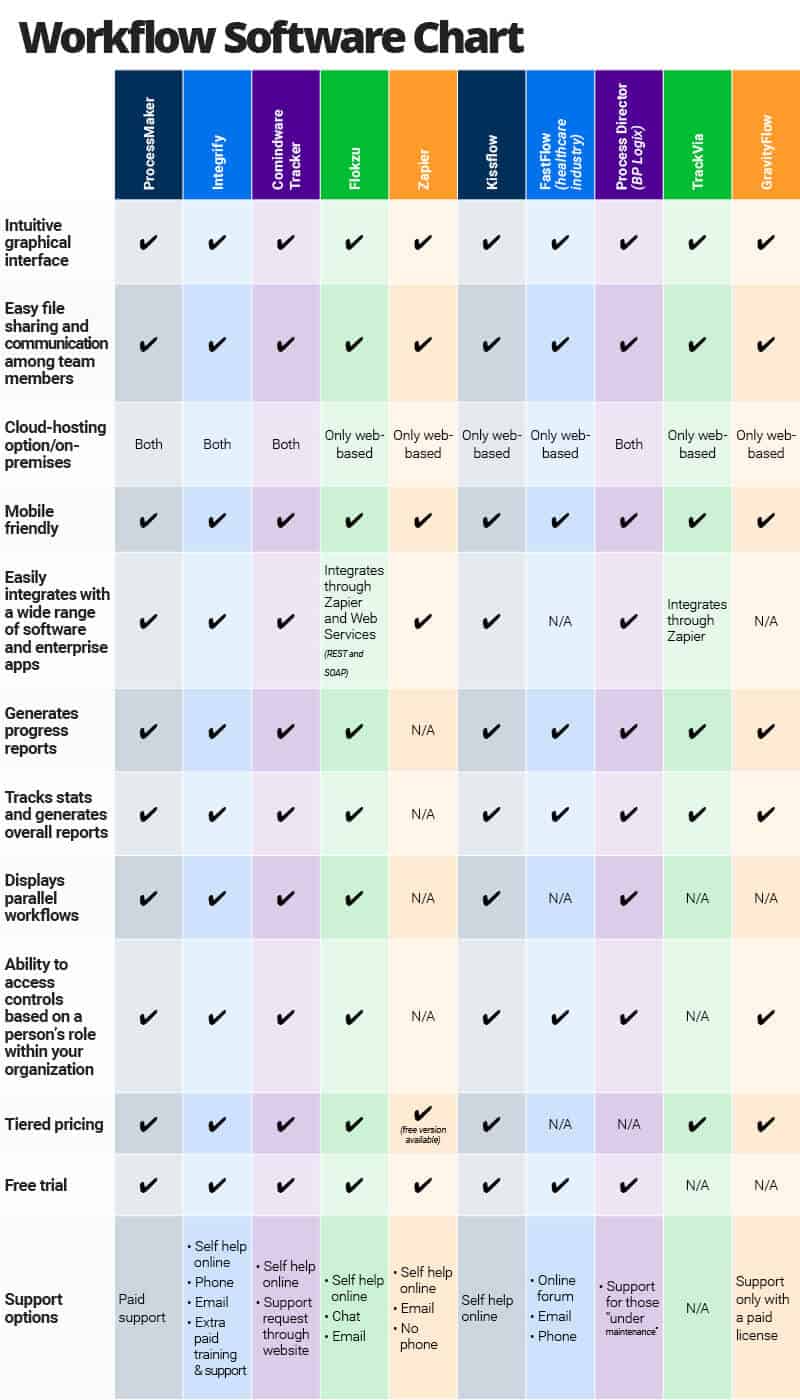What Is Workflow Automation?
Workflow automation is the system by which an organization uses technology to more efficiently complete some of its business processes. If done right, the technology will execute regular and often simple processes more quickly and effectively, freeing up time for an organization’s employees to tackle more complex work.
Background and History of Workflow Automation
The history of workflow automation can be traced back to the 1920s and the pioneering work of Frederick Taylor and Henry Gantt in helping companies and manufacturers understand industrial efficiencies. Taylor and Gantt (who developed the Gantt chart still used today) were some of the earliest management consultants, who helped organizations understand how to more efficiently complete their manufacturing and business processes.
In the 1980s and 1990s, people began using computer technology to help organizations better understand and manage their workflow. The work that technology does is now considered workflow automation.
What Is Automation in Business?
A number of business processes can be done more efficiently if automated (i.e. done with minimal attention from people). Business processes in human resources, accounting and purchasing departments, among others, can be made more efficient through automation.
Why Is Workflow Automation Important?
Workflow automation can help any organization more efficiently and effectively perform regular (and sometimes mundane) tasks that take people longer to do. Because the work is done more efficiently — and sometimes more accurately — automation saves organizations money. It also frees up an organization’s employees to tackle more complex jobs that require more strategic thinking and can’t be automated.
How Workflow Automation Can Benefit Your Organization
Workflow automation can benefit organizations in a number of ways, including the following:
-
Make it easier to manage people
-
Streamline certain business processes
-
Improve workload management
-
Reduce repetitive tasks
-
Help create up-to-date and consistent documents
-
Build custom forms to capture important data and better understand how to use it
-
Allow organizations to more easily analyze their processes and workflows for further improvement
-
Allow for shorter sales cycles
-
Expand ability of employees to work away from main offices
-
Increase customer engagement
-
Help increase options for customer self service
-
Enhance collaboration and communication among team members
-
Allow employees to focus on more complex and strategic tasks
-
Minimize errors
-
Increase accountability
-
Reduce costs
-
Increase employee job satisfaction
-
Increase adherence to compliance rules
-
Reduce approval cycles
Concrete Data on Real-World Benefits of Workflow Automation
Studies have shown that workflow automation can reap real results that can increase a company’s bottom line. For example:
-
The Annuitas Group published survey results that revealed that through a combination of process and marketing automation, the surveyed companies had experienced a 417 percent increase in revenue.
-
Cisco Systems automated their customer relationship management (CRM) process and eliminated 75,000 customer calls per month and saved over $270 million annually in operating expenses, according to the Business Process Management Journal.
Types of Work Where Workflow Automation Can Be Helpful
-
Collecting invoices and sending them to the appropriate processors
-
Confirming each invoice is correct and scheduling supplier payments
-
Collaborating on contracts, procurement requests, and other internal work orders
-
Collecting customer orders and sending them to fulfillment
-
Monitoring the payment status of each account
-
Creating and maintaining employee files in an organization’s human resources department
-
Processing and following up on special customer requests
-
Maintaining a general ledger
-
Invoicing customers for goods or services
-
Collecting contracts and transactional information for financial audits
Is Your Organization Ready for Workflow Automation?
While many of these tasks can be found across many industries and companies, there could be other processes in your business that would benefit from automation. With that in mind, what processes might you consider automating first?
Meisel, the author and efficiency expert, suggests almost every business could be ready for a workflow automation solution — as long as the company has at least $300,000 in annual revenue. If your business is smaller than that, he says, “you need to be focusing on sales” before considering significant workflow automation solutions.
For any business with at least $300,000 in revenue, leaders can ask themselves some basic questions to decide whether proceeding with workflow automation is worth the effort — in essence, when the time and costs would increase efficiency exponentially.
Here are some basic questions to ask:
-
Do you have a repetitive series of tasks to implement?
-
Do you have a process, or a number of processes, that are standardized?
-
Do you already have paper forms for some of those processes?
-
Is miscommunication in your organization common?
-
Is accountability sometimes vague for the effectiveness of your processes?
-
Is the status of a task sometimes confusing or vague to members of your organization?
Steps to Accomplish Workflow Automation
Workflow automation doesn’t just happen. Nor is it something you simply buy off a shelf and install to transform your business processes. Your organization and its leaders need to do some analysis of its current operations to understand where and how it can benefit your business. Here are some primary steps:
-
Identify and map out some of the business processes that are ripe for being improved through workflow automation — including repetitive processes or other processes that need improvement.
-
Define your overall business goals, and outline how improving a specific process through workflow automation can help achieve those goals.
-
Define how you’ll objectively measure whether the workflow automation is improving the business process.
-
Explore workflow automation services or software that can help with those processes.
-
Implement the services or software for a defined test period.
-
At the end of the test period, use the agreed upon objective measures evaluate to whether the automation has improved your business process.
“A workflow automation initiative can be as large, or as small, as a company prefers,” IntelliChief’s Kubicki explains. “They can automate one or two of their most time-consuming processes, or a variety of workflows across their entire organization.”
What Is Workflow Automation Software?
Workflow automation software helps organizations assess their processes, map them, and outline ways to perform them more effectively through automation.
How to Use Workflow Automation Software
The software is most often available as a software as a service (SaaS) application. Most of the software automatically stores data and integrates it with other software and web-based apps your company might use.
Things to Look for in Workflow Automation Software and a Workflow Automation System
You’ll want to look for important attributes in workflow automation software — or any workflow automation system — that will allow it to be effective. Important attributes include the following:
-
The ability to automate multiple workflows across an entire organization
-
The ability to connect with other software and other systems
-
Workflow represented in user-friendly ways, including graphically
-
Cloud-based (or at least the option to use it as cloud-based)
-
Continual notifications when tasks are completed
-
Ability to generate reports showing the progress of the process and larger company goals
-
Ability to show parallel workflows
-
Access controls based on a person’s role within your organization
-
Mobile capabilities
-
Status indicators for service level agreements your organization may have with third parties
Examples of Specific Workflow Software Solutions
There are hundreds of software solutions that can help with workflow automation. Some of the leading solutions include the following:
-
ProcessMaker
-
Integrify
-
Comindware Tracker
-
Flokzu
-
Zapier
-
Kissflow
-
FastFlow
-
Process Director (BP Logix)
-
TrackVia
-
GravityFlow
How do you know which model is right for your company? Use this chart to get an idea of the basic features each offers so you can narrow down the choices to your top three or four products to evaluate.
How Document Capture Automation Can Help Your Business
A type of workflow automation called document capture automation is becoming increasingly important for most businesses. The process, which is part of many workflow automation systems, helps your business capture and store any document — paper, PDF, email, or other documents — as a similar digital file.
The process allows you to more easily sort the document by type of document, extract information from it, and route it to the appropriate department of your business. Document capture automation can significantly increase efficiency, and decrease errors.
How to Achieve Workflow Automation in an E-Business Environment?
Workflow automation can be exceptionally helpful and important in e-commerce. It can help you follow up with customers, deal with customer concerns, and more efficiently execute processes that can help your e-commerce company outperform competitors. Here are several e-commerce processes that can be improved with workflow automation:
-
Cart Abandonment: Studies have shown that a majority of e-commerce “shopping carts” are abandoned before any purchase. One study by eMarketer indicated the value of all of those abandoned carts was nearly $5 trillion in 2015. If those customers are contacted shortly after they abandon their carts, they are more likely to complete an order. Workflow automation software can automatically send emails to potential customers in the hours or days after they’ve abandoned their carts.
-
Customer Service: While much customer service should be performed directly by employees, there are opportunities for workflow automation to supplement their efforts. Some software allows for customers to submit service requests with enough detail that the software can then prioritize and assign the requests to certain customer service teams automatically. The system allows for better management of the requests based on their urgency and topic area.
-
Automated Inventory Management: Workflow automation can help track inventory in real time in online stores, ensuring that customers are informed immediately when an item is out of stock and delivery will be delayed.
-
Help with Invoices: Use workflow automation to track receipts and both paid and unpaid invoices. The software can synchronize that information with other financial information, including tax data.
-
Help with Marketing: Online and social media marketing is vital for e-commerce businesses. A number of services can help schedule social media posts and other online content for your e-business.
-
Encourage and Monitor Online Reviews of Your Product or Service: Nielsen has found that online reviews garnered 70 percent approval from customers, a much higher figure than most forms of advertising. And according to a study conducted by Dimensional Research, upwards of 90 percent of customers say online reviews influence their purchasing decisions.
Workflow software can generate automatic emails shortly after a consumer’s purchase that encourage them to submit online reviews of the product. The email can also follow up with the customer to ensure they were satisfied with their purchase and the purchasing process. -
Help with Analytics: Understanding data about an e-business’s online traffic and its customers’ behavior is vital. Workflow automation software can automatically generate scheduled reports that provide a wide range of that data.
Expert Tips for Considering and Implementing Workflow Automation
Trying to implement workflow automation into your business without thinking strategically will likely lead to failure. That failure will cost your organization time and money, and build an organizational resistance to ever trying it again. So, it’s important to think about and plan which business process you should tackle first and how to implement workflow automation into the process. Here are some recommendations from experts on how to strategically tackle your first workflow automation project:
-
Implement automation only in areas where there’s an obvious need and it makes sense.
-
Focus first on handling the most repetitive tasks.
-
Take existing manual processes and gradually insert automation tools to improve them. Have employees who understand the daily work and issues create a detailed map of each process from end to end. “Many organizations struggle with tribal knowledge – important details that the people who perform certain tasks know as a result of experience, but that aren’t otherwise documented in a company’s official policies,” says Kubicki. “This can lead to certain steps being left out of a newly automated workflow. Companies need to take the time to get with the employees who are in the trenches – not just the CTOs, CFOs, CIOs, or other high-level decision-makers.”
-
Automate both for internal and external engagement.
-
Create — or ensure your workflow automation intrinsically creates — automated connections between various software your company uses.
-
Audit your business processes for potential optimization.
-
Make sure that your company’s workflow automation doesn't require deep technical knowledge to operate.
-
Ensure your employees are available to focus on your core mission and consider eventual automation for everything else. Stay flexible. “Workflows evolve as companies grow,” Kubicki says. “Companies should be evaluating their processes on an ongoing basis, and updating their approach to automation accordingly.”
How Workflow Automation Can Be Helpful in Specific industries
Workflow automation can be useful for specific business process within specific industries. It can also help processes within specific departments in most companies and industries.
Industries
Healthcare:
-
The transfer of information in patient electronic health records that's recorded digitally but can be error-prone if transferred by staff
-
Patient admission and discharge, with doctors handling some some discharges with a mobile application
-
Staff work schedules and on-call rotations
Legal:
-
Automate billing through time-tracking software linked to invoicing software
-
Manage legal case deadlines
-
Use templates to assemble parts of legal documents
-
Submit and track requests for contract reviews and approvals
-
Input new client information
Printing:
-
Ensure that incoming jobs are assigned to the shop's appropriate technology
-
Measure the performance of operators on specific equipment to ensure best operators are assigned to the right equipment
-
Monitor operations and determine where time is long on specific kinds of work
Specific Departments:
Development/Operations:
-
Developing and testing software code
-
Deploying the code
-
Collecting metrics from production
-
Orchestration of the development-operations pipeline
Information Technology:
-
Requests for service
-
Setting up new accounts
-
Requests relating to new projects
-
Dealing with security Incidents
Finance:
-
Capital expenditure requests
-
Expense approvals
-
Changes in salaries
-
Accounts payable automations
Marketing:
-
Approvals for campaigns
-
Managing organizational branding issues
Facilities:
-
Office relocations
-
Scheduling of resources
-
Monitoring access to facilities
-
Requests for employee moves
Sales:
-
Approvals of pricing discounts
-
Approvals of proposals
-
Approvals of quotes
Human Resources:
-
Changes in employee benefits
-
Onboarding details with new employees
-
Managing details on employees leaving organization
-
Vacation Requests
Purchasing:
-
General procurement
-
Approvals of capital expenditures
-
Managing vendors
-
Approvals for invoices
Build Powerful, Automated Business Processes and Workflows with Smartsheet
Empower your people to go above and beyond with a flexible platform designed to match the needs of your team — and adapt as those needs change.
The Smartsheet platform makes it easy to plan, capture, manage, and report on work from anywhere, helping your team be more effective and get more done. Report on key metrics and get real-time visibility into work as it happens with roll-up reports, dashboards, and automated workflows built to keep your team connected and informed.
When teams have clarity into the work getting done, there’s no telling how much more they can accomplish in the same amount of time. Try Smartsheet for free, today.



